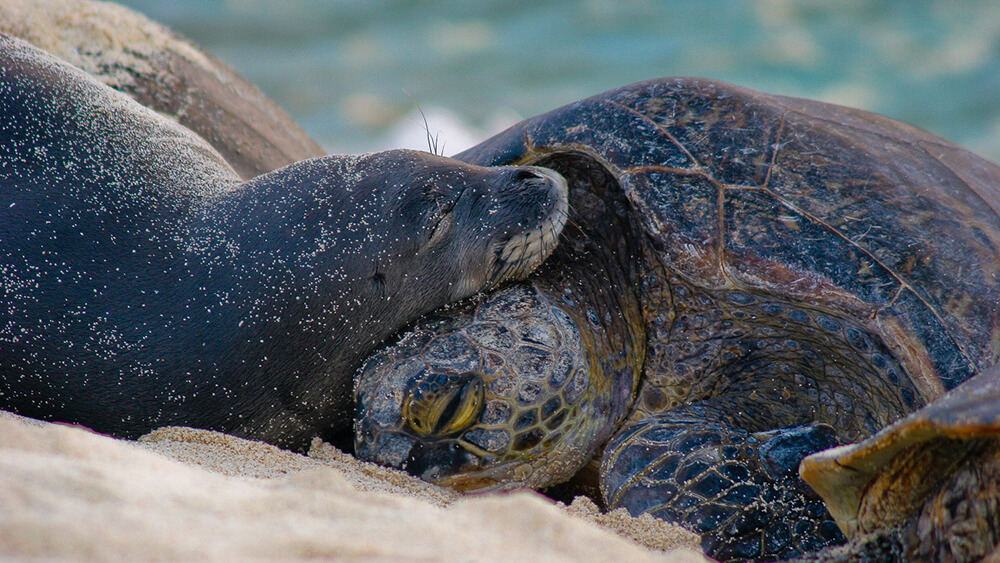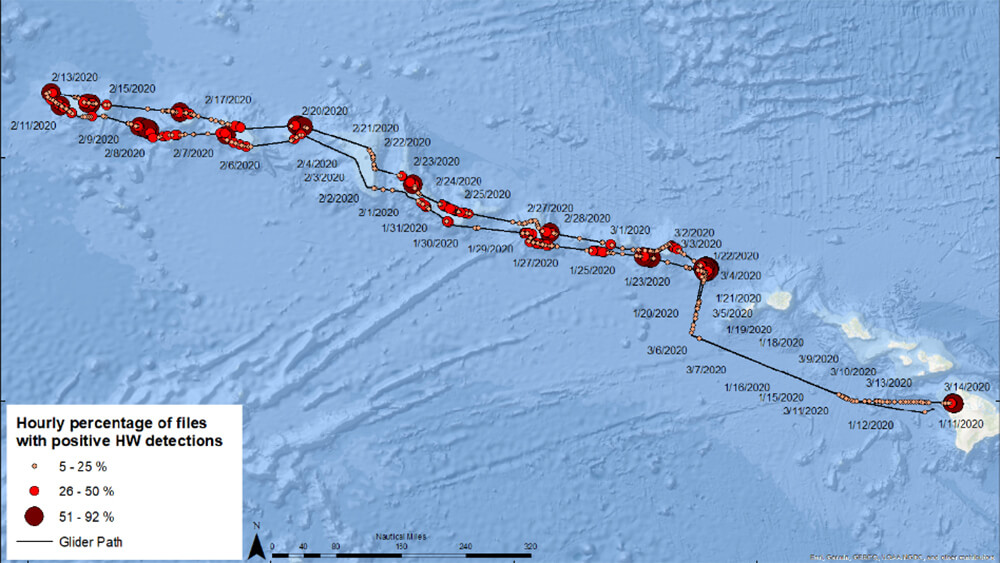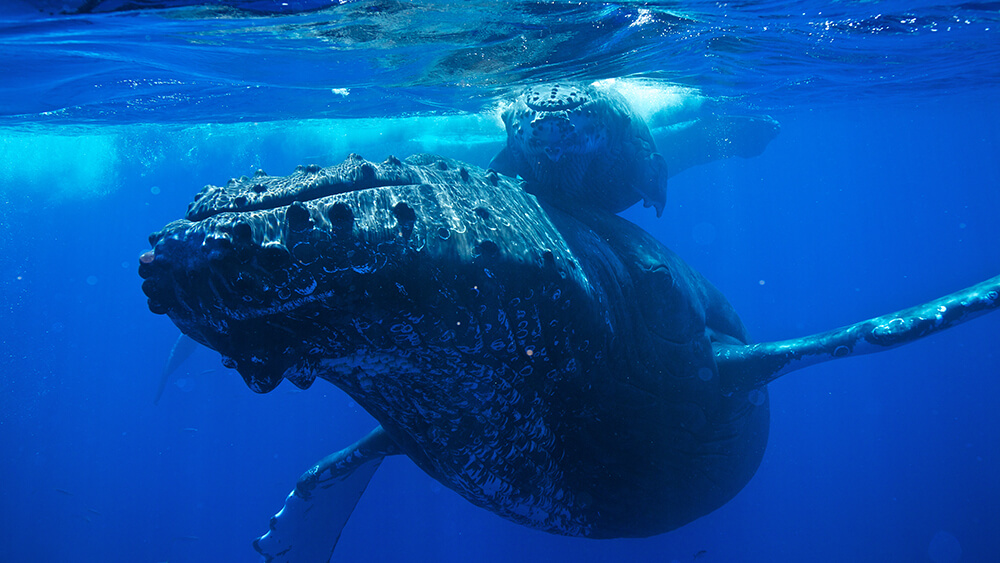Along for the Glide:
What The Wave Glider's Journey Through Papahānaumokuākea Reveals About Humpback Whales
By Haley Randall
July 2021
Spanning over 580,000 square miles—larger than all the national parks in the United States combined—Papahānaumokuākea Marine National Monument's magnitude makes it both a haven for an abundance of life and a challenge to study the creatures that live there. The Wave Glider, a remotely operated surface vehicle, is beginning to change that, having traveled 2,627 nautical miles over the course of 67 days while recording the presence of whales throughout the monument.
You'll be hard-pressed to find another place as breathtaking and ecologically valuable as Papahānaumokuākea Marine National Monument. Home to the highly endangered ʻīlioholoikauaua (Hawaiian monk seal), the threatened honu (green sea turtle), and many species found nowhere else on Earth, the complex and highly productive marine and island ecosystems of the monument are significant contributors to the incredible biological diversity of the Hawaiian archipelago.

Established in 2006 and expanded in 2016, Papahānaumokuākea Marine National Monument is the single largest conservation area in the United States. While the monument's enormity is part of what makes it so special, it's also what makes it difficult to keep tabs on the region's wildlife. Add in tough field conditions such as the monument's prohibitively rough winter seas, and you have a recipe for one formidable study site.
These obstacles have made it particularly challenging to document one of Hawai'i's most beloved and recognizable species, the kohola (humpback whale.) These charismatic cetaceans abound in the archipelago's warm waters during the breeding months of November through May—which unfortunately corresponds with the most difficult time of year to get out into the monument for sea based studies due to adverse field conditions. Fortunately, whale biologists have an unlikely new tool in their quest to study humpbacks in the form of a robotic vehicle called the Wave Glider.
Meet the Wave Glider
On this expedition, Europa was deployed with traditional ti leaves as she was blessed before heading out to the monument. Photo: Jupiter Research Foundation
So what is the Wave Glider, exactly, and how does it help scientists collect data on humpback whales? Named Europa, it was designed by the Jupiter Research Foundation and is one of the most revolutionary and remarkable pieces of technology being used in marine mammal science today. As an autonomous surface vehicle, the Wave Glider is composed of a surface float connected via an umbilical to a sub-surface, winged module.
The Wave Glider uses energy from ocean waves to propel itself by converting the vertical motion of surface waves into forward momentum, or thrust. Solar panels on the exterior of the vehicle power its electronics and internal battery. Just add sunlight and swells to Europa, and you have a self-sustaining piece of research equipment that can stay out on the water much longer than a research team!
Europa recently completed its most ambitious voyage yet as part of NOAA and the U.S. Navy's Sanctuary Soundscape Monitoring Project, also known as SanctSound. SanctSound's overarching goal is to gather data from underwater sound recordings taken from sites across the U.S., including throughout the National Marine Sanctuary System. These recordings can be added to data collected via satellites, visual surveys, and other scientific efforts to better understand and monitor the status of marine life and the environment in national marine sanctuaries.
So how does the Wave Glider fit into this incredible, multifaceted research venture? Europa's ability to power and propel itself and withstand Papahānaumokuākea Marine National Monument's winter seas made it a perfect candidate to gather data on the region's humpback whales. Besides being one of the stormiest times of year on the monument, winter is also one of the most active for humpback whales. Male humpback whales begin to return to the warm, shallow waters of Hawai'i for breeding season beginning in November, and they bring their iconic voices and songs with them.
This is where the Wave Glider comes in—it can navigate across significant distances to the banks, seamounts, and shoals that are so popular among breeding whales, while documenting the relative presence of male humpback whale song throughout the monument. The Wave Glider accomplishes this using a technique called passive acoustic monitoring (PAM). PAM allows the Wave Glider—and by extension, researchers, to listen to life underwater in a minimally invasive way that doesn't disturb wildlife or the environment. By capturing how much sound (or lack of sound) the Wave Glider detects as it traverses the monument, scientists can estimate the relative abundance of humpback whales in the region, which helps them to more effectively manage the population.
Going the Extra (Nautical) Mile
The sun sets over calm water in Papahānaumokuākea Marine National Monument. Photo: Robert Schwemmer/NOAA
The Wave Glider recently completed its first extensive odyssey through Papahānaumokuākea, listening to the monument's humpback whales all along the way. It traveled a whopping 2,627 nautical miles over the course of 67 days - that's equivalent to the roundtrip distance from Washington, D.C. to Denver, Colorado!
A machine-learning model developed by Google in partnership with NOAA's Pacific Islands Fisheries Science Center was used to detect the presence of humpback whale song in the data obtained by the Wave Glider. This tool allowed for efficient and rapid analysis of 92,408 minutes of acoustic recordings that were collected by the Wave Glider over the course of the mission.
The story that the data collected by the Wave Glider tells is both fascinating and important for the future of humpback whale research in Hawai'i. Humpback whale song—which indicates the presence of whales—was detected at every bank or shoal that the Wave Glider visited during its voyage from January 8 to March 14, 2020. Middle Bank, located towards the southeastern end of the archipelago, had the highest prevalence of whale song.

However, song was detected broadly at varying levels all throughout the monument. Higher occurrences tended more towards the northwestern region of Papahānaumokuākea at locations such as Raita Bank and Northampton Seamounts, while lower occurrences were recorded at more centrally-located locations like Gardner Pinnacles.
Informing Management Decisions
Hawaii's waters provide critical winter breeding grounds for humpback whales. Photo: Ed Lyman/NOAA under NOAA permit #7741714
The wave glider traveled farther and longer than others before it, and brought back new data on how much of the area is used by humpbacks. This information will contribute to better understanding and protecting these magnificent mammals.
The results of the glider's survey provided evidence that humpback whales occur widely throughout Papahānaumokuākea Marine National Monument, beyond the main Hawaiian islands. They also suggest that there may be more structure to the distribution of whales than previously thought, raising intriguing questions about whether all humpback whales in the archipelago are indeed part of the same distinct population segment.
While some questions remain to be answered, the survey is already helping to inform NOAA and the U.S. Navy about critical whale habitats and activity in monument waters. Data from the Wave Glider's expedition will help scientists better understand whether there are distinct population segments between the main and Northwestern Hawaiian Islands and lead to better management decisions across the population. This and other data will inform decisions that could help minimize disturbance to whales in the monument and better navigate a future in which climate change will likely affect the migratory and reproductive behaviors of humpbacks.

Findings from the survey also reinforce what researchers have long known to be true about humpbacks: that shallow banks and shoals play a vital role in the life cycle of these whales and provide critical winter breeding ground habitat. Altogether, these findings underscore why Papahānaumokuākea is such an ecologically important marine protected area, and why its continued protection and management is necessary if we are to ensure a viable future for these whales.
Mystery still abounds when it comes to the intimate lives and movements of humpback whales, but one thing is certain: with the Wave Glider at their disposal, there are many more discoveries and breakthroughs ahead for researchers at Papahānaumokuākea Marine National Monument.
Haley Randall is a recreation & tourism intern with NOAA's Office of National Marine Sanctuaries.

